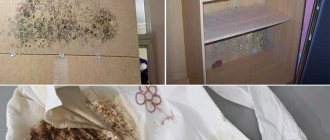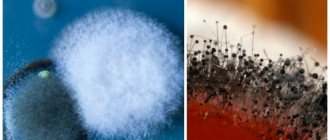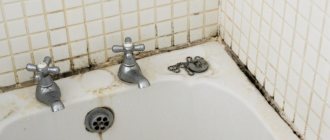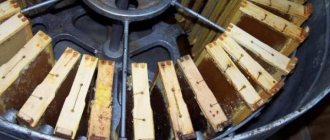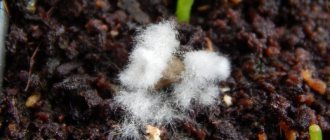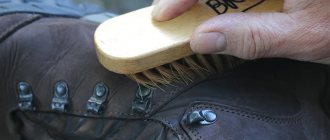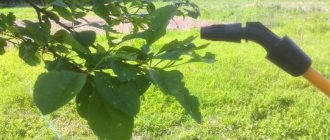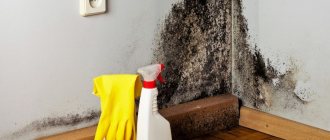By attacking wood, mold spoils its aesthetic appearance. But the main danger of the fungus is not damage to property, but its negative impact on the human body. Spores can provoke an allergic reaction and even cause mycotic pathologies. If the damage is minor, you can remove mold from wood yourself, using antiseptics or improvised means.
Causes of mold formation on wood
Before looking at how to remove mold from wood, it is important to find out why it appears. The first sign that there is fungus in the house is a change in color. A characteristic brown, blue, black, pink or white color appears on the surface of the wood. At first the spots are barely visible. And in the absence of timely treatment, they increase in size and affect large areas of the material.
Some bacteria do not destroy the texture and do not penetrate deep into the wood. But they can ruin the aesthetic appearance of wood trim, floorboards or wall cladding. There are several reasons why fungus appears on wood:
- improperly organized ventilation in the room;
- high humidity;
- sudden temperature changes;
- condensate;
- low-quality wooden material;
- infection of wood by fungi;
- contact with damp soil for a long time.
Mold fungus is dangerous not only because it multiplies quickly, but also because it has a negative impact on people and pets. If you use material contaminated with mold to build or decorate a house, the consequences can be very serious, including the complete dismantling of wooden structures.
Folk remedies
In order to effectively remove mold from a wood surface, it is not necessary to spend a lot of money on purchasing professional mixtures. Often all the components are at home and you just need to know how to mix them correctly.
These ingredients include:
- hydrogen peroxide;
- copper sulfate for wood processing;
- table vinegar 9%;
- borax;
- ammonia;
- drying oil or glue;
- baking soda;
- sodium bichromate;
- resin;
- liquid soap;
- boric acid;
- bleaches containing chlorine;
- iodized salt.
Silicate glue is not used in concentrated form; the substance is diluted with distilled water in equal proportions. The resulting slurry is applied to the surface of the wood. For more detailed instructions, see the end of the article.
Read also: How to wear a figure eight scarf
Copper sulfate is an effective chemical, but it also should not be used in its pure form. One hundred grams of powder is dissolved in ten liters of water. Afterwards, the mixture must be poured into a spray bottle. The liquid is used to treat wood, as well as walls, slopes and ceilings.
Resin is also an effective method of control, but it cannot be used within a residential area. All treatments must be carried out outside the premises.
Before removing the black spots, pay attention to how deeply the infection was able to penetrate inside. If the situation is quite advanced, then traditional methods cannot be used and you will have to resort to radical measures - mechanically remove part of the damaged material (with a plane, saw, ax), and it is better to throw away the boards that are too contaminated.
Step-by-step removal of mold in wooden products
Elimination of consequences and prevention of further proliferation of fungal spores is carried out in several stages. How to remove mold from a wooden surface if the problem is found in a neglected state:
- Cleaning damaged areas. You will need a spatula and a chisel. Remove the top layers with a spatula. A chisel and knife are used if damage to the internal structure of the wood is detected.
- Dispose of all removed wood. It is advisable to burn all cut layers of wood.
- Washing the material. Prepare a concentrated solution of laundry soap and carefully treat cleaned wooden surfaces.
- After treatment with soapy water, the wood is allowed to dry. Then they are treated with a wood antiseptic. After disinfection, the wood is allowed to dry and the treatment of problem areas is repeated.
Important! You need to apply an antiseptic not only to areas damaged by mold, but also to areas around it. There may be spores scattered there that have not yet had time to manifest themselves.
Why do boards, beams, logs and lumber turn black?
Wood is the best natural and environmentally friendly material for building your own home. Yes, this is true, because in addition to its aesthetic qualities, a wooden house is warm, safe for the health of the people living in it, and does not cause allergies. In addition, it is always comfortable in a wooden house. In summer there is a gentle coolness, in winter it is moderately warm, and the humidity level is always normal. As you can see, wood has many properties that can easily outperform any building material. Unfortunately, just like any coin has two sides, wood, if stored and used improperly, may develop shortcomings that make it unsuitable for construction.
How to clean boards from mold
There are two ways to clean boards from mold: call a specialized service that specializes in removing infected areas or get rid of the fungus yourself. If large-scale wood damage is detected, it is better to use the services of specialists. Since such companies determine the type of disputes and select the most effective means of destruction. In addition, processing is carried out with professional equipment.
If you decide to remove the fungus yourself, a person will need to prepare tools for the work and disinfectants that destroy mold spores.
Premises requirement
To prevent mold from bothering you, it is necessary to carry out the necessary work to insulate the basement or panel seams. In addition, replacing plastic windows with hinged models is considered the best option.
It is advisable to provide additional ventilation if possible.
Preventive treatment of premises against mold and mildew:
- It is necessary to treat problem areas with vinegar or hydrogen peroxide.
- It is necessary to ventilate the room more often.
- If there is a basement, then it is necessary to check the level of melt and groundwater, to ensure that moisture from them does not enter the room.
- Install casement windows.
- Allow damp areas to dry overnight.
How to get rid of mold on a wooden surface
If the material is only slightly affected, the following will help get rid of mold:
- chisel and spatula;
- sandpaper;
- hammer;
- soft rags and fine sandpaper.
The scale of mechanical intervention depends on the depth of penetration of fungal spores. Sometimes it is enough to remove the thin top layer and then perform disinfection without severe damage to the timber.
Antiseptic
A properly selected chemical solution will destroy mold growth areas. As a rule, universal antiseptics and active fungicides are used for these purposes. The following have proven themselves well in the fight against disputes:
- Tikkurila;
- Belinka;
- Neomid.
Important! Any chosen anti-mold product is used strictly according to the instructions. In addition to the recommended dosage, it is important to pay attention to the optimal temperatures at which processing is performed.
We recommend:
How to clean a silicone case
These antiseptics do not contain dangerous chlorine compounds and volatile toxins. At the same time, they are capable of not only destroying areas of bacterial growth, but also subsequently protecting the wood from spores. In addition, there are solutions that additionally have a toning effect. This allows the lumber to retain its natural appearance.
Folk remedies
Before treating the timber against fungus and mold using professional means, you can try traditional methods of combating it. Such means were successfully used for control even before special chemical solutions appeared on the construction market. Among the most popular are the following:
- Acetic acid. Lumber is treated with acetic acid in two stages. Spraying is performed for the first time. After complete drying, wipe again with a dampened rag. This method is completely safe, but gives a short-term effect.
- Hydrogen peroxide. Carefully treat the damaged areas with peroxide and leave for 15 minutes. Then clean the surface with a metal brush. The disadvantages include the risk of losing the appearance of the material.
- Baking soda. Add water to the soda and stir thoroughly until a thick paste is obtained. The product is applied to the damaged areas and left for 30 minutes. Then the surface is cleaned with a stiff brush.
- White. The most effective and most dangerous way to destroy mold fungi. Whiteness is applied to the areas where spores have been identified and left for 15 minutes. Wash off with soap concentrate.
Important! When planning to resort to folk remedies to combat mold, you should not use highly concentrated chlorine solutions. When using such products, you must wear a protective mask and rubber gloves.
Folk remedies are not always effective, and in some cases even dangerous to human health. Therefore, it is better to give preference to modern antifungal drugs with a multicomponent composition.
Sequencing
To combat pathogenic flora that destroys wood, it is important not only the product, but also the preparation of the surface.
To achieve maximum effect, you need:
- Choose suitable conditions - the outside temperature should not be lower than 5℃. Sunny, warm and dry weather is considered optimal.
- Prepare the surface - use a metal brush to remove any lesions and allow to dry thoroughly.
- Apply the product - if the damage is deep, it makes sense to apply the treatment 3-4 times, leaving time intervals for complete drying.
- Treat with a protective coating - to protect the wood from further destruction, after disinfection it is necessary to open it with paint and varnish compounds that prevent the absorption of moisture and the development of rot.
Have you ever had to deal with mold on wood?
It happened, it didn't happen
It is recommended to destroy peeled wood shavings with obvious signs of mold. The best way is to burn it in a fire. If you throw it in the trash or bury it in the ground, the fungus will continue to exist, and its spores can reappear on wooden surfaces.
How to prevent mold
After disinfection, it is important to take preventive measures. This will not only destroy all mold, but also prevent its occurrence in the future. The rules of prevention are not complicated and consist of the following steps:
- ensuring good air circulation;
- eliminating sources of high humidity. If the house has a basement, regular ventilation and heating will be required;
- maintaining stable temperature;
- annual treatment of wooden facades and finishing with a special antiseptic.
Private wooden houses are most susceptible to mold. Therefore, it is important to avoid mistakes when arranging ventilation, waterproofing and insulation. Since even with modern antiseptics, it is very difficult to completely remove mold. It is much easier to prevent it from appearing.
Rate this post
Prevention methods
The set of preventive measures will take less time than treating a simple fungus at home. Problems are easier to prevent, so it is important to ensure their ventilation in a bathhouse or wooden house.
Hydro- and vapor barrier
The main reason for the formation of pathogenic microorganisms is excessive humidity levels and the influence of steam. It is important to protect furniture and structures from this. Therefore, it is imperative to use special varnishes that protect the wood.
In a room where the humidity is always exceeded due to objective factors, for example, in a bathhouse, it is necessary to ensure a pleasant microclimate and regular ventilation.
Roof and foundation integrity
Before putting the house into operation, the roof and foundation must be covered with paints, varnishes and antiseptics. The appearance of fungus in these structures is not always noticeable, but as a result they grow and cause harm. Cleaning and application occur only on a clean surface; brushes, sprayers and rollers are used.
Vapor barrier membrane for protection against condensation
A vapor barrier membrane will protect against condensation and serve as an additional measure. The event is presented as a whole.
Preventing food contamination
Who wants to suffer from food poisoning? Follow these simple tips to avoid such problems:
Buy hard acrylic or rubber boards as they are the most hygienic to use (these are the boards commonly used in restaurants). Wooden boards should be disinfected regularly and kept as clean as possible. It is convenient to have several boards for different types of food. You should have at least two of them: one for raw meat and fish, the other for vegetables, bread and any other foods that can be eaten raw. Buy colored sets of cutting boards or label the boards yourself, this will make it much easier to distinguish them by purpose. Throw away any cutting boards that have cracks, large scratches, or obvious signs of dirt.
Like all kitchen utensils, cutting boards have an expiration date and it is important to dispose of them promptly to maintain kitchen hygiene and cleanliness.
Processing cutting boards
Most wooden cutting boards are made from hardwoods such as teak, although bamboo cutting boards are also quite common. Any type of wood should be treated to prevent stains and keep food odors and bacteria from lingering on the surface.
Use an oil that can be used repeatedly, such as food-grade mineral oil.
It is safe and will fill the pores of the wood well. Another name is liquid paraffin, edible petroleum jelly. Rub the oil onto the board and let it soak into the wood. Wipe off excess oil with a clean, dry cloth. Repeat this process at least once a month.
Attention! Do not use vegetable oil on cutting boards. This oil will go rancid and cause an unpleasant odor.
After mineral oil, apply beeswax
, it will make the surface of the board waterproof, which will protect the wood from wear and tear and extend its service life. In a microwave-safe container, microwave 1/2 teaspoon (2.5 ml) beeswax with 1 cup (240 ml) mineral oil for about 45 seconds. Apply warm wax to cutting board. Based on materials from www.cleanipedia.com, ru.wikihow.com
Wooden kitchen cutting boards have many advantages compared to their plastic and ceramic counterparts. Products do not slip on their surface, allowing you to cut them much more confidently and quickly. In addition, dense wood, in addition to its environmental friendliness, is also famous for its durability, so wooden boards last much longer than their other analogues.
But wooden cutting boards have their drawbacks. The main ones are the ability of wood to absorb odors and change its appearance for the worse. In order for the board to last longer, it is necessary to properly care for it. I hope now you know how to do it :o)….
Over time, kitchen boards absorb odors, and this problem can no longer be solved by simply washing. It’s not very pleasant to cook on such a household item, but you shouldn’t throw it away right away, since cutting boards in the kitchen can be cleaned effectively and in a short time.
Rules of care
Typically, all care requirements can be read on the label that accompanies any product. It indicates whether the item can be washed or should only be dry washed. If you can wash it, it will say at what temperature it is best to do it.
Can the item you purchased be ironed, or is it better to simply dry it on a horizontal surface, having first smoothed out all the wrinkles and irregularities?
If your items can be ironed, then pay attention to your own iron. It should make it possible to adjust heating modes, depending on the fabric from which your clothes are made
It should allow you to adjust the heating modes, depending on the fabric from which your clothes are made.
When you are ready to wash, check the clothes for stains. If stains are found, they should first be washed separately and only then washed as a whole. It is imperative to sort things depending on color (or according to the principle of whether they shed or not).
All zippers and buttons must be fastened. Delicate, delicate items are best washed in bags and for them you should not set the spin mode to too high a speed.
You should air dry your clothes, but try to keep things out of the sun in summer, this will protect them from fading. It is better to dry woolen items horizontally to avoid them being pulled out; under no circumstances should you use a radiator to dry woolen items.
Preventive wood treatment
Reducing the humidity level (less than 70%) and high-quality ventilation will help protect internal surfaces. Impregnating or coating external structures with antifungal products is a must for a long-lasting structure. Folk or ready-made remedies can be used. So, Tikkuril primers are applied before painting or varnishing.
The coating is renewed when damage occurs. The affected area is cleaned and additionally treated with an antifungal drug. The entire surface of the façade can be preventively coated with a mold preventative every 3-4 years.
- The material is attacked by various microorganisms that destroy it and harm human health.
- Mold develops due to high humidity, poor ventilation and insufficient maintenance, leading to the formation of cracks in the material, creating favorable conditions for spores.
- Wood is a porous structure; chlorine and ammonia compounds are not suitable for cleaning it. It is better to stick to essential oils, boron and commercial products.
- Folk and ready-made remedies are used for preventive treatment. You also need to monitor the cleanliness (integrity) of the facade and the microclimate in the premises.
Interesting! In the United States alone, these microorganisms cause $73 billion worth of damage to structures annually.
The destruction of structures exposed to infection occurs quickly. It is difficult to get rid of pests due to the deep penetration of spores. It is better to treat materials preventatively and regularly inspect structures to remove pathogens in the early stages of development.
Rules for applying protective equipment
When processing wood, the following points should be considered.
- An effective processing method is immersion. Alternative methods are to use a brush or spray bottle.
- The preparations cannot be mixed; simultaneous exposure is destructive to wood fibers. Each subsequent product is applied only after the previous one has been completely absorbed and dried.
- An increase in the degree of protection is achieved either by highly concentrated preparations or by the number of layers applied.
- You should not treat wet and frozen wood, since an antiseptic is the same moisture, and wood containing water is not able to fully absorb.
- It is better to choose a warm season for processing.
- Antiseptics and fire retardants should be applied using personal protective equipment, since chemical burns to the skin are possible if the drugs come into contact with unprotected areas of the body.
- Another point that affects the quality of processing is the implementation of preparatory manipulations with lumber before starting work with it. That is, treatment with antiseptics and fire retardants before changes occur in the structure of the tree under the influence of fungi, when it is possible to treat the tree from all sides, and not just its visible part in the structure.
For each situation in the processing of wooden materials there is an individual solution. If we are talking about a floor board, for example, in an apartment, then an antiseptic or varnish coating will be sufficient. If we are thinking about protecting rafters in a private house, then using varnish will be useless, unless open rafters are part of the design of the room, but additional fire protection in two or three layers will be the optimal solution.
Seek advice and purchase wood protection products from specialists. Long-lasting buildings!
Ways to “treat” damaged lumber
The first way to save wooden building material is to treat it with antiseptic solutions before darkening occurs.
When asked what to do if the boards become moldy, blue or blackened, there is only one answer: immediate treatment.
The algorithm of actions is as follows:
- Wood bleach treatment. Let's say the timber has darkened by 3-4 centimeters, this can be seen in the cross section. Bleach will help here, penetrating up to 5 centimeters deep.
- Treatment with an antiseptic agent that prevents the development of bacteria in the body of the board.

